The Feedstock Whisperers: BETO’s upgraded Biomass Feedstock National User Facility is open for business
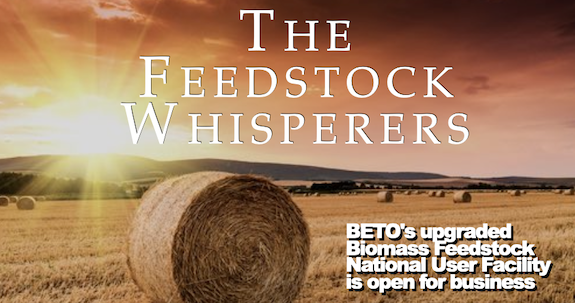
By Katie Carnahan and Michelle Goff, Idaho National Laboratory
Special to The Digest
Bioenergy plays a key role in achieving net-zero goals. As with any technical process, costly setbacks can arise if the best technologies are not available. The upgraded Biomass Feedstock National User Facility (BFNUF) at Idaho National Laboratory (INL) addresses many of the challenges facing the U.S. bioenergy industry. The research conducted at the facility supports advanced feedstock supply logistics, post-harvest quality management, material handling, preprocessing, scale-up, and advanced fractionation and separation technologies. All of these make bioenergy technologies more accessible and effective by improving feedstock quality at minimal cost.
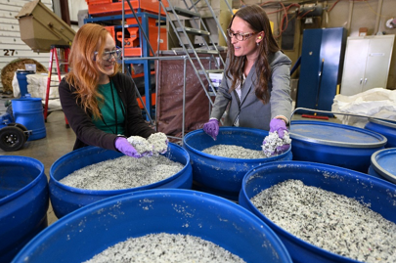
INL researchers view MSW post-processing at the Biomass Feedstock National User Facility.
The upgrades provide one of the most versatile feedstock preprocessing facilities in the world, featuring equipment capable of processing agricultural waste, forest residue, municipal solid waste, biosolids, sludges, food waste, plastics.
INL has a wide array of preprocessing capabilities. Automated sorting and separation remove rocks, metals or other unwanted items. Advanced milling and fractionation alter material properties for improved feedstock quality, while material handling and feeding system design address flowability challenges. Finally, INL also offers size reductionand densification, blending, formulation, and packaging final quality feedstocks for shipping to a conversion partner.
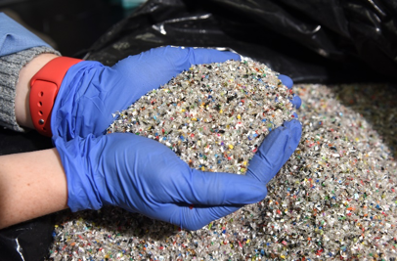
Mixed plastic municipal solid waste.
The facility’s flagship is its biomass feedstock Process Development Unit (PDU). The equipment’s innovative design — modular and reconfigurable at many scales — helps bioenergy companies find the best way to convert biomass into conversion ready feedstock for their processes.
The PDU can process and characterize raw materials starting at gram quantities and scale up to multiple-ton, industrial-grade bales. It harnesses techniques like sorting, segregation, feeding, mill size reduction, rotary and solvent drying, pelleting, blending and cubing. It also provides unique packaging options. The unit offers unparalleled versatility by addressing many sorting and processing needs in one space.
Changing the Game With Garbage
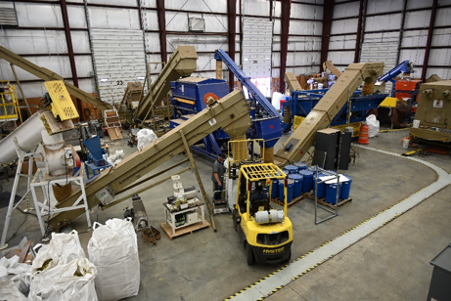
Various processing equipment housed in the Biomass Feedstock National User Facility’s Process Development Unit.
One processing project underway in the facility focuses on municipal solid waste. INL bioenergy researchers Vicki Thompson and Rebecca Brown are leading new research that supports the Department of Energy’s efforts to process and decontaminate municipal solid waste, specifically for use as biofuel feedstocks. Municipal solid waste is garbage from homes, schools and businesses. It can include paper, plastic, food, clothing and construction or demolition waste.
“The goal of the project is to be able to use nonrecyclable waste to create biofuels,” Brown said. “Even though not all municipal solid waste comes directly from a plant-based organism, most of most of what we are using is derived in part from organic matter.”
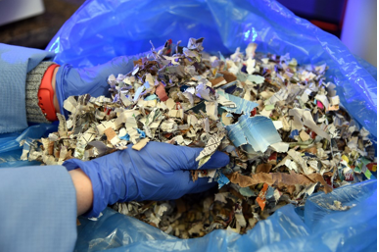
Mixed paper municipal solid waste.
Nonrecyclable waste includes items that are either too contaminated or too expensive to recycle. Some of the most common contaminants are food products, such as grease left on a pizza box, paper products that include other materials like metal or plastic, and other waste, including dirt from yard waste, with inorganic contaminants. Ink and adhesives on paper are also major contamination culprits. Adhesives can cause significant problems by gumming up machinery that converts the paper into a form usable for biofuels.
Pre-preprocessing: Chemical Characterization
In addition to preprocessing capabilities, the upgraded BFNUF houses the Biomass Characterization Laboratory and the Bioenergy Feedstock Library. Together, these resources generate and house the data for a living archive of biomass feedstock characteristics. The library is continuously updated with new search tools and physical feedstock samples to help researchers and industry evaluate feedstock quality characteristics and formulation procedures. Understanding the unique chemical characteristics of specific materials allows them to determine the best processing methods based on the individual material’s density, moisture, structure, and size characteristics. Such tailored methods contribute to the larger goal of reducing processing setbacks and costs.
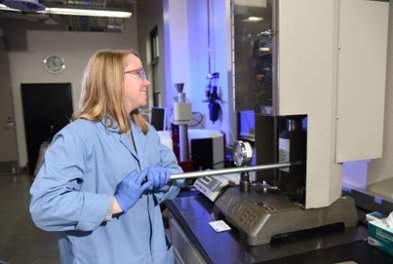
Rebecca Brown, INL staff scientist, presses plastic MSW into pellets for biofuel conversion.
Thompson and Brown are involved in research that characterizes the municipal solid waste fractions of plastic and paper to determine what contaminants might affect biofuel conversion. They then work to decontaminate them and increase the yield for fuel and product conversion.
“Our team also supports preprocessing of municipal solid waste to meet biofuel production goals,” Thompson said.
Any item directly derived from organic materials can be converted into sugars, which can then be fermented into biofuels. Municipal solid waste can also include food waste, which is typically broken down easily via anaerobic digestion.
Plastics are another key component of municipal solid waste. “Because plastics are petroleum-based, our goal is to recycle as many of them as possible to reduce our reliance on petroleum,” Thompson said. With their preprocessing capabilities, the INL team is focused on plastics that are not typically recycled in the United States.
In addition to preprocessing, Thompson and Brown are decontaminating municipal solid waste to enable ease of recycling or conversion to biofuels. Decontamination methods can range from a simple water wash to a high-temperature thermochemical treatment or chemically based solvent extraction process, which uses pressure to strip contaminants from organic matter.
Preprocessing municipal solid waste and keeping it out of landfills are essential actions for meeting nationwide goals to combat climate change. As they decompose in landfills, some of these materials generate methane, an even more environmentally toxic gas than carbon dioxide.
Post-preprocessing: Outside partnerships and the future of biomass
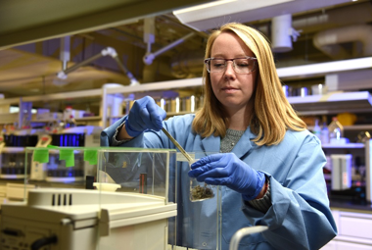
Rebecca Brown, INL staff scientist, examining MSW samples.
INL works with a variety of external customers to address their individual processing needs. Through a recently funded project with Gas Technology Institute, INL researchers will use BFNUF capabilities to help develop advanced preprocessing technologies. Some of these technologies will employ artificial intelligence and machine learning for predictive models, while others will enhance a feedstock using torrefaction, a form of pyrolysis that changes biomass properties to improve fuel quality for combustion or gasification applications.
While there are many components of the project, the overall goal is to facilitate a new commercialization pathway for the GTI U-GAS® fluidized bed gasification technology. The collaboration is part of a larger effort to improve bioenergy resource recovery and conversion systems and is one of many examples of how the BFNUF contributes to advancing the bioenergy preprocessing space.
One of many novel green processes answered by research conducted at the BFNUF is sustainable aviation fuel production. Supply chain and logistic challenges, as well as feedstock quality concerns, are addressed by developing and implementing improved waste sourcing and fractionation processes, all of which are heavily researched at the BFNUF. The knowledge gained through research at the BFNUF will improve a variety of bioenergy industry processes, including sustainable aviation, by making more low-value materials accessible as feedstocks for sustainable conversion processes.
“Right now, contaminated municipal waste is a bit of a negative value,” Brown said. “We can’t do much with it when it’s being put into a landfill. The average contamination rate of recyclables is 17%. If we can successfully decontaminate this waste and use it as fuel, its efficacy skyrockets beyond that of standard recyclable waste. If we can implement these strategies at biorefineries, our decontamination opportunities could become available on a national and even global scale.”
The capabilities detailed here merely scratch the surface of the upgraded BFNUF. As one of the premier bioenergy research facilities, it continues to secure accessible and efficient biomass processing technologies. Using the BFNUF, INL will continue to improve bioenergy production and contribute to enabling a net-zero future.
About Idaho National Laboratory
Battelle Energy Alliance manages INL for the U.S. Department of Energy’s Office of Nuclear Energy. INL is the nation’s center for nuclear energy research and development, and also performs research in each of DOE’s strategic goal areas: energy, national security, science and the environment. For more information, visit www.inl.gov. Follow us on social media: Twitter, Facebook, Instagram and LinkedIn.
Category: Top Stories















